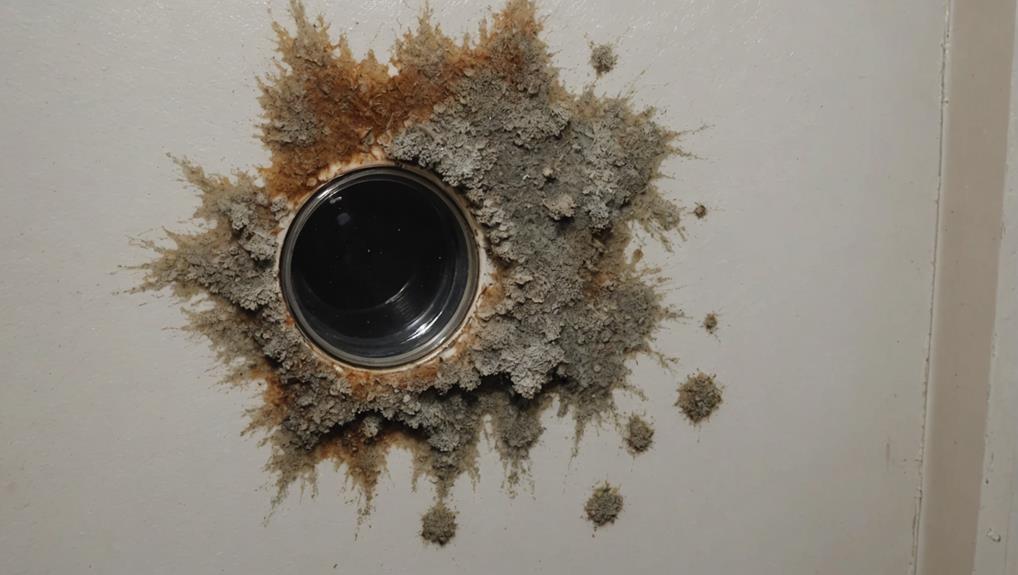If you've been experiencing sneezing, coughing, or skin irritation, mold might be the culprit. Mold can thrive in damp environments and may release spores that trigger allergic reactions and respiratory issues. Prolonged exposure can lead to more severe health risks, including chronic respiratory conditions and neurological symptoms. You should inspect your home for visible signs of mold, particularly in moisture-prone areas. It's also essential to manage humidity levels. Recognizing how mold affects your health is the first step to addressing the problem, and there's more to investigate regarding prevention and assessment strategies that could keep you safe.
Understanding Mold and Its Effects

Although mold is a natural part of our environment, it can pose substantial health risks, especially when it proliferates indoors. Understanding mold biology is essential for anyone seeking to maintain a healthy indoor environment. Mold thrives in environments with heightened indoor humidity, often exceeding 60%. This moisture creates a perfect breeding ground for various mold species, which can release spores into the air, compromising air quality.
Mold biology encompasses the life processes of these fungi, including their reproduction and growth. Most molds reproduce through spores that can remain viable for extended periods, waiting for the right conditions to germinate. When indoor humidity levels rise, these spores can quickly colonize surfaces, leading to increased exposure.
The presence of mold indoors not only indicates moisture problems but can likewise lead to structural damage over time. By proactively managing indoor humidity—ideally keeping it between 30-50%—you can greatly reduce the likelihood of mold growth. Taking control of your environment by understanding these biological processes empowers you to mitigate risks and protect your health. Recognizing the interplay between mold biology and indoor humidity is the first step toward a safer living space.
Common Symptoms of Mold Exposure
When exposed to mold, you might experience a range of symptoms that can impact your daily life. Common issues include respiratory problems like coughing and wheezing, skin reactions such as rashes, and even neurological symptoms like headaches or memory lapses. Understanding these signs is essential for identifying and addressing potential mold-related health concerns.
Respiratory Issues
Mold spores, often invisible to the naked eye, can infiltrate indoor environments and trigger a range of respiratory issues. When inhaled, these spores may provoke an immune response, leading to symptoms that can disrupt your daily life. If you're experiencing mold allergies, you might notice symptoms like sneezing, nasal congestion, or a persistent cough. These reactions are your body's way of signaling that something is amiss.
In more severe cases, mold exposure can worsen existing respiratory conditions, such as asthma or chronic obstructive pulmonary disease (COPD). You may find yourself struggling to breathe or experiencing wheezing as your airways narrow in response to the irritants. Even though you don't have pre-existing conditions, prolonged exposure to mold can lead to heightened sensitivity, making you more susceptible to respiratory infections.
Understanding these symptoms is essential for taking action. If you suspect mold is present in your environment, identifying and eliminating it should be a priority. By addressing mold exposure proactively, you can protect your respiratory health and regain control over your well-being. Don't underestimate the impact of these spores on your life; they can have significant consequences on your respiratory system.
Skin Reactions
Exposure to mold can lead to a variety of skin reactions that may go unnoticed until they become bothersome. You might experience skin allergies manifesting as redness, itching, or swelling. These reactions often occur when your immune system identifies mold spores as harmful, triggering an inflammatory response.
Common symptoms include rashes that can range from mild irritation to severe dermatitis. These skin issues may not appear immediately; they can develop over time with continuous exposure to mold. If you notice unusual skin changes, it's vital to assess your environment for potential mold sources.
When seeking relief, effective rash treatments depend on the severity and type of reaction. Over-the-counter antihistamines can ease itching, while corticosteroid creams may reduce inflammation. Nonetheless, consulting a healthcare professional is advisable for persistent symptoms, as they can recommend tailored treatments or allergy testing.
Understanding the link between mold exposure and skin reactions empowers you to take proactive measures. By eliminating mold from your surroundings and addressing any reactions promptly, you can protect your skin health and regain control over your well-being.
Neurological Symptoms
Many people overlook the neurological symptoms that can arise from mold exposure, yet they can greatly impact daily life. If you're experiencing these issues, it's vital to recognize the signs and understand their implications. The effects of mold can lead to considerable cognitive decline and mood disorders, ultimately affecting your productivity and well-being.
Here are three common neurological symptoms linked to mold exposure:
- Memory Issues: Difficulty recalling information or concentrating can hinder your ability to function effectively at work or home.
- Mood Changes: Increased anxiety, depression, or irritability might stem from mold exposure, making it challenging to maintain healthy relationships and manage stress.
- Neurological Discomfort: Symptoms like headaches, dizziness, or even tremors can notably disrupt your daily activities and overall quality of life.
Recognizing these symptoms is important. If you suspect mold exposure is affecting your mental health, consider seeking professional help. Addressing the underlying issue could not only mitigate these neurological symptoms but additionally restore your sense of control and power over your life. Don't underestimate the impact mold can have on your cognitive and emotional well-being.
Identifying Mold in Your Home

To effectively identify mold in your home, start by recognizing common types that may be present, such as black mold or aspergillus. Conduct a thorough visual inspection of areas prone to moisture, like bathrooms and basements, while in addition paying attention to any musty odors that might indicate hidden growth. By being proactive in these observations, you can better address potential mold issues before they escalate.
Common Mold Types
Identifying common mold types in your home is crucial for maintaining a healthy living environment. Understanding the various mold types can empower you to take control of your space and mitigate potential health implications. Here are three prevalent mold types you should be aware of:
- Aspergillus: Often found on food and in damp areas, Aspergillus can produce mycotoxins, which may lead to respiratory issues or allergic reactions.
- Stachybotrys chartarum (Black Mold): This notorious mold thrives in wet, damp conditions and is known for its severe health implications, including chronic fatigue and neurological issues.
- Penicillium: Commonly found in water-damaged buildings, Penicillium can cause allergic reactions and respiratory problems, particularly in sensitive individuals.
Recognizing these mold types is the first step in addressing any potential issues in your home. By being proactive, you not only protect your health but likewise create a safer living environment. If you suspect any mold presence, taking immediate action can make a significant difference in your overall well-being.
Visual Inspection Tips
A thorough visual inspection of your home can reveal hidden mold problems that may compromise your health. To effectively identify mold, utilize specific mold identification techniques and create a detailed visual inspection checklist. Start in areas prone to moisture, such as bathrooms, kitchens, and basements. Look for discoloration on walls and ceilings, particularly in corners and around windows.
Check for water stains, peeling paint, or wallpaper, which can indicate a mold problem. Pay close attention to hidden spaces, like behind appliances and under sinks; these areas often harbor mold because of dampness. If you notice any visible mold, document its location and size for future reference.
Also, inspect your HVAC system, as mold can thrive in ducts and filters. Don't forget to examine your roof and gutters; leaks can lead to mold growth in your attic or walls.
Musty Odor Detection
After completing a thorough visual inspection, the next step in identifying mold in your home involves paying attention to any musty odors. These odors can be potent indicators of underlying mold growth, and recognizing them can empower you to act decisively.
To improve your odor detection methods, consider the following:
- Identify Musty Odor Sources: Focus on areas prone to moisture, such as basements, bathrooms, and kitchens. Check behind appliances and under sinks where water might accumulate.
- Utilize Your Senses: Trust your nose. If you notice a persistent, damp smell that seems out of place, it may signal hidden mold.
- Conduct a Moisture Assessment: Use a moisture meter to measure humidity levels in suspected areas. High readings often correlate with mold growth.
Health Risks Associated With Mold
Mold can pose significant health risks, particularly for individuals with allergies or respiratory conditions. When mold spores enter your indoor environment, they can trigger a cascade of health issues, ranging from mild allergic reactions to severe respiratory complications. You might experience symptoms such as sneezing, coughing, or skin irritation, which can escalate into more serious conditions like bronchitis or asthma exacerbations.
Moreover, prolonged exposure to mold can lead to chronic health problems, including fungal infections, especially in those with weakened immune systems. Understanding these risks underscores the importance of health awareness; knowing how mold affects your body is vital for taking decisive action.
Preventing mold growth is not just about maintaining a clean space; it's about safeguarding your health and well-being. By addressing humidity levels, ensuring proper ventilation, and promptly addressing leaks, you empower yourself to mitigate these risks. The interplay between mold exposure and health highlights the necessity for vigilance. Prioritizing mold prevention isn't merely a home maintenance task; it's a fundamental step in preserving your long-term health. Stay informed, take action, and protect yourself against the hidden dangers that mold can impose.
Preventing Mold Growth

Understanding the health risks associated with mold highlights the significance of preventing its growth in your home. Implementing effective mold prevention strategies can empower you to maintain a safe living environment. Here are three vital techniques you should adopt:
- Control Moisture: Mold thrives in damp conditions, so controlling moisture is paramount. Use dehumidifiers in high-humidity areas and guarantee proper ventilation in spaces like bathrooms and kitchens.
- Seal Leaks Promptly: Inspect your home regularly for leaks in roofs, pipes, and basements. Addressing these issues quickly can prevent moisture accumulation and subsequent mold growth.
- Regular Cleaning: Keep surfaces clean and dry, especially in areas prone to moisture. Regularly cleaning and disinfecting can deter mold spores from settling and proliferating.
Steps to Take If Exposed
If you've been exposed to mold, it's vital to take immediate steps to mitigate any potential health risks. First, assess your exposure level. If you notice symptoms like coughing, sneezing, or skin irritation, it's imperative to act swiftly. Begin with mold testing; this will determine the type and extent of the mold present. Identifying the specific mold can guide your next steps effectively.
Once you've confirmed the presence of mold, initiate a thorough clean up. Wear protective gear, including gloves and a mask, to shield yourself from spores. Seal off the affected area to prevent further spread. Use a mixture of water and detergent for small areas, or consider a professional remediation service for extensive infestations.
After the clean up, monitor your health. If symptoms persist, consult a healthcare professional, as prolonged exposure can lead to more serious health issues. Finally, document your findings and actions taken; this could be vital for any potential claims or remediation efforts moving forward. Taking these steps empowers you to reclaim your environment and safeguard your health against the harmful effects of mold exposure.
Conclusion
In summary, if you suspect mold is affecting your health, it's essential to act swiftly. Remember, "an ounce of prevention is worth a pound of cure." By understanding the symptoms, identifying mold in your home, and taking proactive measures, you can protect yourself and your loved ones. Don't underestimate the impact of mold; addressing it early can prevent serious health risks and create a safer, healthier living environment. Your well-being is worth the effort.
